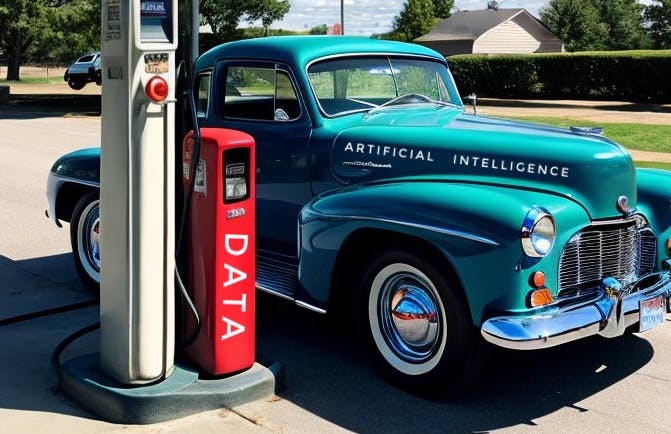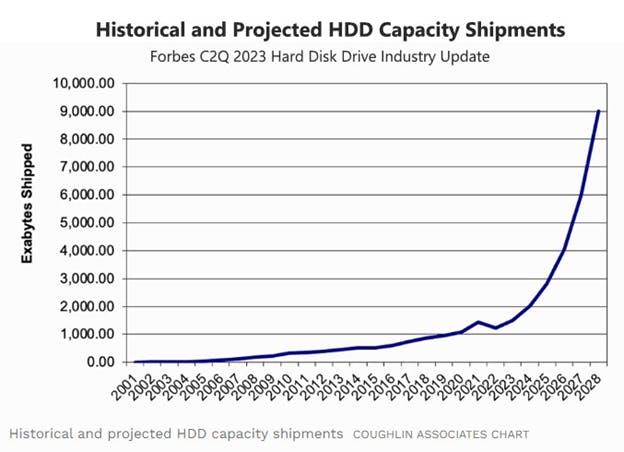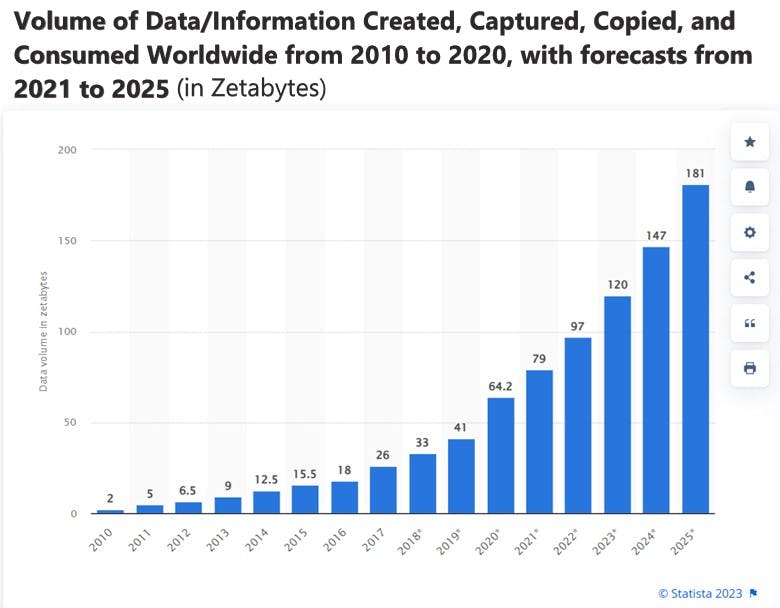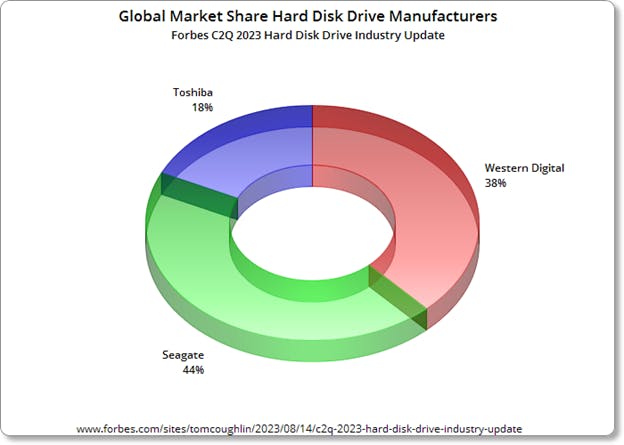The loudest voices in the room are talking about AI and the need for more processors, but few—aside from hard drive manufacturing legend Finis Conner—are talking about hard disk drives (HDDs). In this article, we explore Conner’s perspectives on AI, and the potential for an AI-triggered HDD supply chain crisis, one that could bring trillion-dollar tech companies and global digital ad empires, temporarily, to their knees.
Everything is moving to the cloud, especially when it comes to data. But the critical thing to remember about “the cloud” and “cloud data storage” is the fact that they still require cold, hard disk drives (HDDs) down here on Earth. Typically, these HDDs are found in vast server farms—like the 7.4 million-square-foot “Citadel” facility in Nevada.
The other thing to remember about cloud data storage is that the AI revolution is driving the need for more of it. This is why Google (1), Microsoft (2), Meta (3), AWS (4), and other tech giants are spending billions on new data centers. It’s also why cloud storage is getting more expensive, and why HDD manufacturers are releasing bigger drives. 50 terabyte drives are coming in late 2024 (6).
All of this should be excellent for hard disk drive makers. However, according to analysts, hard disk stock prices are falling and HDD makers are reducing production. So what’s going on? I asked this question to hard drive manufacturing legend and co-founder of Seagate, Finis Conner, and the conversation that followed was jaw-dropping.
“The answer is complicated,” he said. “On one level, it’s connected to an HDD supply surplus from the pandemic. On a more concerning level, it brings the potential for an HDD supply crisis that could, temporarily, bring trillion-dollar companies to their knees.”
Content Overview
- The Context: Data Is the Fuel for AI, and Hard Drives Are Needed to Store It
- The Need for Cloud Storage Is Rising, But HDD Stock Prices Continue to Fall
- Why Are Hard Disk Stocks Falling When Demand for Data Storage Is Rising?
- Sounding the Alarm
- The Danger: Only 3 Hard Drive Companies Supply All HDDs in the World, Down From Over 40 Manufacturers Several Years Ago
- Other Risks to HDD Supply
- The Opportunity: If HDD Manufacturers Prepare, They Can Profit From AI’s Rising Storage Demands, While Protecting Global Supply Chains and the Margins of Their Customers
- Final Thoughts
- Sources
The Context: Data Is the Fuel for AI, and Hard Drives Are Needed to Store It
Data Is the Fuel for AI and AI Needs HDDs to Store It
When AI systems have more and better quality data, they can better forecast future trends, automate tasks—and most importantly, generate more value. Tesla is a good example of this. The massive amount of data Tesla collects from its electric vehicles (7) allows the company to train its powerful AI driving models.
Social media and internet search platforms are another great example. As outlined in a previous article on Conner’s blog (Democratizing the New Data Economy in 2023)(8), these platforms exist primarily to harvest user data, analyze it with AI, and serve targeted and customized digital ads to their users. The fact that global digital ad revenue is projected to reach $679.80 billion in 2023 (9) is proof of the value and importance of AI and data (that’s more than the GDP of Switzerland)(10).
AI-based automation systems also need data to train the algorithms that currently threaten to replace an estimated 300 million global jobs, as per a recent Goldman Sachs report (11). According to Goldman Sachs:
“We find that two-thirds of current jobs are exposed to some degree of AI automation, and that generative AI could substitute up to one-fourth of current work […] generative AI could expose the equivalent of 300 million full-time jobs to automation.”
This Goldman Sachs report is not only terrifying; it highlights the scope of change and the incredible value that AI brings to the table. In fact, it’s precisely because of that value—and AI's dependence on data—that many businesses are building sophisticated strategies to store and understand the data they have on their customers, employees, accounting, and overall business operations.
According to a 2022 Mckinsey report, “The Data-Driven Enterprise of 2025 (12)”:
“By 2025, smart workflows and seamless interactions among humans and machines will likely be as standard as the corporate balance sheet, and most employees will use data to optimize nearly every aspect of their work […] Those able to make the most progress fastest stand to capture the highest value from data-supported capabilities. Companies already seeing 20% of their earnings before interest and taxes (EBIT) contributed by artificial intelligence (AI), for example, are far more likely to engage in data practices that underpin these characteristics.”
As an important aside, traditional manufacturers also need data storage. In fact, a lack of storage can stop large production facilities in their tracks. The most recent example of this happened last month (13), when Toyota unexpectedly stopped production at 28 assembly lines in 14 Japanese auto plants—all because “an error occurred due to insufficient disk space, causing the system to stop.”
The Need for Cloud Storage Is Rising, But HDD Stock Prices Continue to Fall
To service the growing demand for data storage, cloud storage providers are building new data centers (14) at a breakneck pace. A recent statement from Blackstone’s chief investment strategist Joseph Zidle confirms that demand for cloud storage is on the rise (15):
“The explosive growth in data driven by cloud computing, content creation, and the AI revolution [...] is driving demand for data centers in our portfolio and elsewhere […] It’s natural to think of AI as an esoteric, abstract concept; a form of intangible software. In reality, real-world data centers anchor AI.”
As further proof that cloud storage is in demand, a 2023 report from Schroders (16) revealed the following:
“Forecasters estimate that total demand for data centers, as defined by power consumption, could hit 35 gigawatts (GW) by 2030 in the U.S. market alone, up from 17 GW in 2022 […] Data centers, as the critical infrastructure behind the digital economy, are set to play a key role in delivering new AI tools to consumers and businesses.”
In terms of dollars and cents, Fortune Business Insights said that the global data storage market is expected to grow from $247.32 billion in 2023 to $777.98 billion by 2030 (17).
The fact that more companies need more data—and more places to store it—should be bullish for HDD makers. But the global HDD industry—serviced by only three manufacturers—is currently in a slump. Since their 2022 highs, stock prices for the three HDD manufacturers have been falling. Seagate is down by 48%, Western Digital is down by 32%, and Toshiba is down by 32% (as of Sept. 25, 2023). Finally, Barclays downgraded Seagate (18), citing a worse-than-expected recovery of its HDD business.
Why Are Hard Disk Stocks Falling When Demand for Data Storage Is Rising?
The drop in HDD stock prices and declining HDD orders are very real (see analysis from Robert Castellano (19). But they don’t seem to make sense when you think about the coming wave of AI and the increasing need for data storage. To understand what’s happening, Finis Conner’s view of the HDD industry can help.
Conner spent the last 45 years watching the ebb and flow of demand for hard disk drives. He’s seen disk drives grow from the tape storage systems that filled a room, to the 5.25-inch 5-megabyte drives that he sold to Steve Jobs in the 1980s, to the 30-terabyte (30,000,000 megabytes) disk drives that Seagate launched in July 2023 (20).
No stranger to economic cycles in the HDD industry, Conner offers a clear explanation for the slump:
“We can point the finger at COVID. Reduced global business and manufacturing activity during the pandemic caused a decrease in demand for disk drives and cloud storage. This resulted in a massive surplus in hard drive supply. It’s temporary, but the HDD surplus is still hurting sales and negatively impacting HDD stocks in 2023.”
To stop the bleeding, HDD manufacturers are currently reducing CapEx (capital expenditure), lowering production capacity, and reducing personnel to balance their costs. According to Conner, these measures are a financial necessity for HDD firms, but lowering production capacity—immediately before the AI tsunami strikes—creates the potential for a dangerous situation:
“Remember that it will take a lot of time to start the HDD production engine back up again. While it’s true that HDD orders are retreating, the wave of AI—and its demand for data storage—is growing by orders of magnitude, and so is its ravenous hunger for data. It reminds me of a tsunami, and right now the disk drive industry is seeing the waters pull back, and wondering why. My serious question is, will the three HDD makers be ready for it when the tide eventually turns, and the big wave hits?”
Sounding the Alarm
As we stand at the brink of an AI wave—the scale and size of which the world has never seen—the AI conversation has mostly centered around AI’s disruptive potential, the growing demand for processors, and the need for more cloud storage. But this is where Conner brings us back to earth:
“The AI conversation is mostly focused around processors and cloud storage, but cloud storage relies on HDDs, period. Solid-state flash drives are great, but they’re still too expensive. Tapes are being used, but only for legacy data. All of the new data being created by AI will need more hard disk drives to store it on. If they can’t increase HDD production exponentially when the need arises, cloud data storage and AI simply won’t be able to grow with the demand."
Horizon Technologies (21) has the same view as Conner that the AI wave will drive demand for more HDDs:
“With AI coming into its own, many firms anticipate a considerable surge in demand [for hard disk drives] as enterprises look to channel the continuing surge in data, monetizing it via analytic insights.”
The following forecast from data storage analyst Tom Coughlin further supports Conner’s assessment that exponentially more HDDs will be needed in the years ahead. Featured in a recent Forbes article (22), Coughlon projects a 900% increase in HDD capacity shipments from 2020 to 2028:
Image Source: Forbes (22)
Robert Castellano’s September 2023 analysis (19) of HDD manufacturers also corroborates the need for more hard disk drives in the years ahead. According to Castellano, hard disk drive manufacturers are “major beneficiaries of the increased storage demands for AI, with HDDs expected to dominate data centers for the next 10 years.”
Of course, the increasing demand for storage isn’t new. What’s new is the speed at which the demand for storage is skyrocketing. According to estimates from Statista (23), the volume of data created, captured, copied, and consumed worldwide has increased 60-fold from 2010 to 2022. These increases are getting faster each year.
Image Source: Statista (23)
The Danger: Only 3 Hard Drive Companies Supply All HDDs in the World, Down From Over 40 Manufacturers Several Years Ago
At this time, getting more cloud storage happens with the touch of a button—and it’s still very affordable. But can we rely on cheap and easy access to cloud storage in the face of sharply increasing demand? Here, Conner offers another chilling point:
“Only three HDD manufacturers are responsible for supplying 100% of all the hard drives in the world. That’s down from 40-plus companies several years ago. Now, it’s just Seagate, 44%, Western Digital, 38%, and Toshiba, 18%.”
Data Source for Chart: Forbes (22)
In case you’re not paying attention, this is the ‘wake-up’ comment. With a combined market cap value of only $41.2 billion for all three (as of Sept. 26, 2023), a single Elon Musk-style purchase could buy all three of these firms. More likely, a series of mergers and acquisitions will bring the number of HDD manufacturers down to just two and further centralize the supply chain.
In fact, this consolidation process has already begun. In late September 2023, Barron’s reported (24) that Western Digital is working on a deal to sell off its solid-state flash drive (SSD) business. Also, Toshiba is about to be acquired (25) in a $14 billion deal that will take the company private.
When asked about the possibility of two firms supplying all of the world’s hard disk drives, Conner said:
“These mergers and acquisitions in the HDD sector are timely. They show change is already in process. But more than that, consider the roughly $40 billion value of the three HDD manufacturers and compare it to the value of the cloud data storage businesses of Apple, Google, and AWS combined. That’s over $6 trillion. These numbers don’t add up to the enabling value HDD suppliers bring to the table. It seems like nobody is paying attention to the importance of these companies—and the overall fragility of the HDD supply chain.”
When you understand the critical role that HDDs play in sectors like AI, digital advertising, and cloud storage, it certainly begs the question: Could we be undervaluing the three companies that manufacture the HDDs tech firms rely on?
Indeed, it seems like everything depends on HDDs—the $108.69 billion (26) cloud storage market, the $679.80 billion (27) digital ad market, trillion-dollar tech companies, large-scale global manufacturers, and the coming AI revolution. Shouldn’t it be of global, economic, and national interest to protect the HDD supply chain?
Other Risks to HDD Supply
As a final and important consideration, the AI tsunami isn’t the only danger to the disk drive supply chain. Intensifying geopolitical conflict, a lack of raw materials, a shortage of electronic components, a natural disaster, or another pandemic could reveal how fragile the global HDD supply chain is in a heartbeat.
An example of this is the 2011 flood in Thailand (28), which devastated global HDD production. The event had multi-year consequences for the pricing and availability of drives. More recently, there have been shortages of processors (29) due to the pandemic. A perfect storm would involve an event like this in the context of an unexpected, AI-fueled rush on cloud storage.
Conner mentions a scenario that—although temporary—wouldn’t be pretty:
“If the big three can’t keep pace with an unprecedented spike in HDD demand because they decommissioned so many factories, there’s a possibility that it could seriously disrupt the business models of trillion-dollar companies and large-scale manufacturers.”
Despite these concerns, Conner remains optimistic:
“The hard drive industry has experienced events like these before and survived. If the past is any indicator, there could be disruptive times ahead, but they will find a way through just like they did in the past. The management teams are very responsive to these major disruptions.”
The Opportunity: If HDD Manufacturers Prepare, They Can Profit From AI’s Rising Storage Demands, While Protecting Global Supply Chains and the Margins of Their Customers
The goal of this article isn’t to say that an HDD supply chain crisis is imminent. Rather, the intention is to sound the alarm on its potential—because the consequences of ill-preparation could be severe.
Although it would be a temporary situation, an HDD supply chain collapse could bring the potential of driving up HDD prices, hindering AI progress, impinging the affordability and effectiveness of digital ads, complicating global manufacturing, impeding global supply chains, and temporarily threatening the business models of trillion-dollar tech companies.
On the other hand, if HDD manufacturers adequately prepare for the possibility—by equipping themselves to ramp up production or by making supply chains more resilient—they could turn a potentially disruptive moment into a tremendous opportunity to protect global supply chains and sell more drives at prices their customers can afford.
As for how drive makers can prepare, Conner suggests an idea to get the conversation started:
“They could reduce risk and bring more control back to managing the HDD supply chain by returning more production to the U.S. just like what the semiconductor industry is doing with incentives from the U.S. government.”
Final Thoughts
With all the uncertainty surrounding the rise of AI—and how it will impact different industries—it’s hard to know what’s coming around the corner, not just for our jobs and our businesses, but for the human condition as we know it.
As for how it will affect the HDD industry, this last perspective from Conner offers a bird’s eye view of what lies ahead:
“AI is coming whether we like it or not, and the fuel for AI is data. But just like electric cars need batteries, if you don’t have a place to store the data, your AI can’t do anything. That means AI could bring something unprecedented for the HDD industry. In this respect, it’s key to anticipate solutions for managing a radical increase in demand, not just to prevent a supply chain disruption, but also to scale and grow as a result of it.”
Sources
- Google files for three-building data center campus in Belgium. (2023, July 10). DCD. www.datacenterdynamics.com/en/news/google-files-for-three-building-data-center-campus-in-belgium
- Welsch, C. (2023, June 5). Microsoft announces its first cloud region in Italy, accelerating innovation and economic opportunity - Microsoft News Centre Europe. Microsoft News Centre Europe. news.microsoft.com/europe/2023/06/05/microsoft-announces-its-first-cloud-region-in-italy-accelerating-innovation-and-economic-opportunity
- Raymond, A. (2022, September 30). Meta announces mega expansion to Facebook data center in Utah - Deseret News. Deseret News. www.deseret.com/utah/2022/9/30/23380151/facebook-meta-announces-expansion-eagle-mountain-data-center-tax-breaks
- Haranas, M. (2023, January 23). AWS Pouring $35 Billion In Data Centers Amid Amazon Layoffs | CRN. CRN. www.crn.com/news/data-center/aws-pouring-35-billion-in-data-centers-amid-amazon-layoffs
- Lardinois, F. (2022, March 15). Google Cloud gets more expensive. TechCrunch. techcrunch.com/2022/03/14/inflation-is-real-google-cloud-raises-its-storage-prices
- Humphries, M. (2023, June 8). Seagate Tests 5 Terabyte Disks, Paving the Way for 50TB Hard Drives. PCMAG. https://www.pcmag.com/news/seagate-tests-5-terabyte-disks-paving-the-way-for-50tb-hard-drives
- Harris, M. (2023, March 29). The Radical Scope of Tesla’s Data Horde. IEEE Spectrum. spectrum.ieee.org/tesla-autopilot-data-scope
- Hillpot, J. (2023, Feb. 23). LinkedIn. www.linkedin.com/pulse/democratizing-new-data-economy-2023-how-big-tech-taking-finis-conner
- Statista. (n.d.). Digital Advertising - Worldwide | Statista Market Forecast. www.statista.com/outlook/dmo/digital-advertising/worldwide#ad-spending
- GDP by Country - Worldometer. (n.d.). www.worldometers.info/gdp/gdp-by-country
- Goldman Sachs. The Potentially Large Effects of Artificial Intelligence on Economic Growth (Briggs/Kodnani). (2023, March 27). GS Research. www.gspublishing.com/content/research/en/reports/2023/03/27/d64e052b-0f6e-45d7-967b-d7be35fabd16.html
- The data-driven enterprise of 2025. (2022, January 28). McKinsey & Company. www.mckinsey.com/capabilities/quantumblack/our-insights/the-data-driven-enterprise-of-2025
- Corporation, T. M. (2023, August 2). Concerning the production order system malfunction | Corporate | Global Newsroom | Toyota Motor Corporation Official Global Website. Toyota Motor Corporation Official Global Website. global.toyota/en/newsroom/corporate/39732568.html
- Miller, R. (2022, November 1). The new MegaCampuses: the world’s largest data center projects. Data Center Frontier. www.datacenterfrontier.com/featured/article/11436953/the-new-megacampuses-the-worlds-largest-data-center-projects
- Zidle, J. (2023, August 1). Joseph Zidle on LinkedIn: Explosive Growth in Data | Pattern Recognition. LinkedIn. www.linkedin.com/posts/joseph-zidle-10744421_explosive-growth-in-data-pattern-recognition-ugcPost-7092238225007595520-DnMV
- Forster, B. (2023). How AI is set to accelerate demand for data centres. Schroders. www.schroders.com/en-gb/uk/intermediary/insights/how-ai-is-set-to-accelerate-demand-for-data-centres
- Data Storage Market Size, Share, Trends | Growth [2023-2030]. (n.d.). www.fortunebusinessinsights.com/data-storage-market-102991
- Ciaccia, C. (2023, September 7). Seagate slips as Barclays downgrades, citing weaker hard disk drive business. Seeking Alpha. seekingalpha.com/news/4009862-seagate-slips-barclays-downgrades-weaker-hard-disk-drive-business
- Castellano, R. (2023, September 12). Seagate And Western Digital: Benefiting From AI And Generative AI Storage Demand. Seeking Alpha. seekingalpha.com/article/4634645-seagate-and-western-digital-benefiting-from-ai-and-generative-ai-storage-demand
- Norem, J. (2023). Seagate ships first HAMR drives for revenue at 32TB. ExtremeTech. www.extremetech.com/computing/seagate-ships-first-hamr-drives-for-revenue-at-32tb
- Horizon Editorial & By Horizon Editorial. (2023, August 10). Hard Drive Capacity and The Road to 50TB - Horizon. Horizon. horizontechnology.com/news/hard-drive-capacity-and-the-road-to-50tb
- Coughlin, T. (2023, August 14). C2Q 2023 Hard Disk drive Industry update. Forbes. https://www.forbes.com/sites/tomcoughlin/2023/08/14/c2q-2023-hard-disk-drive-industry-update/?sh=1daeea7a7616
- Data growth worldwide 2010-2025 | Statista. (2023, August 22). Statista. www.statista.com/statistics/871513/worldwide-data-created
- Savitz, E. J. (2023, September 20). Western Digital stock rallies on better demand, potential Flash-Memory merger. Barron’s. www.barrons.com/amp/articles/western-digital-stock-flash-memory-merger-c2e73d2d
- Yamazaki, M. (2023, September 21). Toshiba says $14 billion takeover bid by JIP succeeds, set to go private. Reuters. www.reuters.com/markets/deals/jip-gains-7865-stake-toshiba-through-tender-offer-2023-09-20
- Statista. (2023, August 2). Size of the cloud storage market worldwide 2022-2030. www.statista.com/statistics/1322710/global-cloud-storage-market-size
- Statista. (n.d.). Digital Advertising - Worldwide | Statista Market Forecast. www.statista.com/outlook/dmo/digital-advertising/worldwide
- Arthur, C. (2017, February 21). Thailand’s devastating floods are hitting PC hard drive supplies, warn analysts. The Guardian. www.theguardian.com/technology/2011/oct/25/thailand-floods-hard-drive-shortage
- J.P. Morgan. (2023, April). Supply chain issues and autos: When will the chip shortage end? www.jpmorgan.com. www.jpmorgan.com/insights/current-events/supply-chain/supply-chain-chip-shortage
Also published here.





